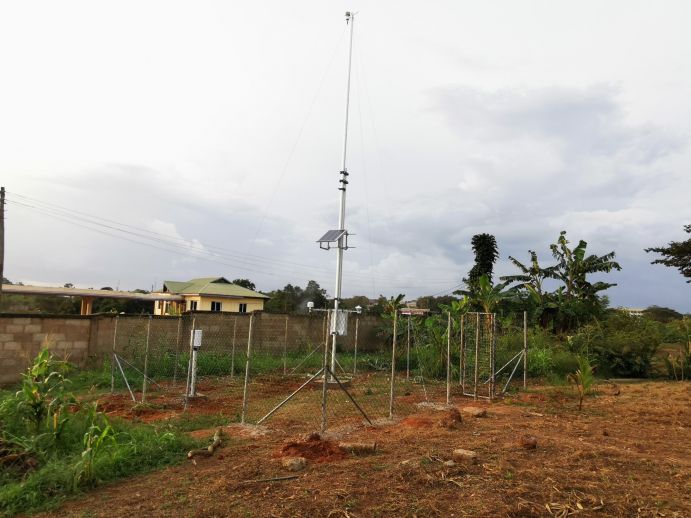Automatic Weather Stations installed at the pilot sites in Ghana
A team of German and Ghanaian researchers and technicians installed the equipment to collect meteorological data at the health facilties in Kumasi, Akwatia, and Kologo for the EnerSHelF project sponsored by the Federal Ministry of Education and Research.
At the end of September, a team from University of Augsburg (UniA) and West African Science Service Centre on Climate Change and Adapted Land Use (WASCAL) met in Ghana to install Automatic Weather Stations (AWS) for the collection of meteorological data at the three pilot sites of the EnerSHelF project. Within the project, both partners collaborate in work package (WP) 3.2 under the lead of UniA to collect and evaluate in situ climate data (You can read interviews with both partners here and here). The aim of the WP is to forecast the key meteorological variables for solar power generation and consumption at the field sites.
Thereby, WASCAL acts as an interface between the EnerSHelF project teams in Germany and local stakeholders, for instance, the Ghana Meteorological Agency. Furthermore, they are responsible to provide technical support in collecting and processing observational data from the local observatory networks. The installation of the AWS at the three field sites spread over a period of 14 days and the field trip's schedule included a close engagement with local authorities, securing materials and civil works, as well as mounting of sensors and testing the installed equipment.
Engagement with Local Authorities
Before going to Ghana, Dr. Windmanagda Sawadogo from UniA visited the WASCAL competence center (CoC) in Ouagadougou, Burkina Faso, for planning the installation of the AWS. During his visit, he met with Dr. Seyni Salack and the director of the WASCAL CoC - Prof. Kehinde Ogunjobi. Prior to their arrival, the team sent official letters to the pilot sites St. Dominic's Hospital at Akwatia and St Michael's hospital at Pramso Kumasi to formerly coordinate its next steps with the local authorities and the hospital administrators. In the case of the third pilot site, Kologo Health Center, the University for Development Studies took over the engagement with the traditional authorities.
On arrival, the team met with each facility authority for official introduction and finalization of the sites for the installation. These included a meeting with the Navrongo District health director, the director of the Kologo Health Center and the Chief of Kologo. In Kumasi, the team was warmly received by the hospital estate officer, who they met with the hospital administrator and the medical director. Later, Dr. Emmanuel Ramde of Kwame Nkrumah University of Science and Technology (KNUST) joined the team. At St. Dominic's Hospital, the team met with the hospital administrator Rev. Fr. Abban, who led everyone to the construction site for the AWS and later introduced the biomedical engineer Daniel to assist in the installation work.
Materials and Civil works
For the installation of the AWS, most of the materials – including fence poles, tower and rain cause basement bolts and nuts – were prepared in Bolgatanga. The civil works included the construction of a 7x7m fence, 70x70cm and 40x40cm concrete platforms for the main tower to mount the sensors and rain gauges respectively throughout all the stations. Also, three 20x40cm plinths for each station were constructed for the support of the tower. Trenches were dug for the PVC pipe layout to connect all cables from the rain gauges and the soil sensors to the logger boxes. This is to ensure that all cables connected from the sensors to the loggers are unexposed.
Mounting of sensors and testing
In the last step of the installation, the various sensors on the poles were mounted and tested. All sensors were installed at a height that is in conformity with the World Meteorological Organization's recommendation and measure the following: Air temperature, global radiation, wind speed and direction, rainfall, pressure and soil temperature (measured at 50, 25 and 5 meters). Connecting and testing of sensors were done by displaying the instantaneous values using the IP addresses of the loggers. The stations were properly grounded to secure them from lightning and thunder. In general, the field work carried out by UniA and WASCAL has been a success despite the COVID-19 pandemic. All installed AWSs are running well and the data are available at 5 minutes time steps.




